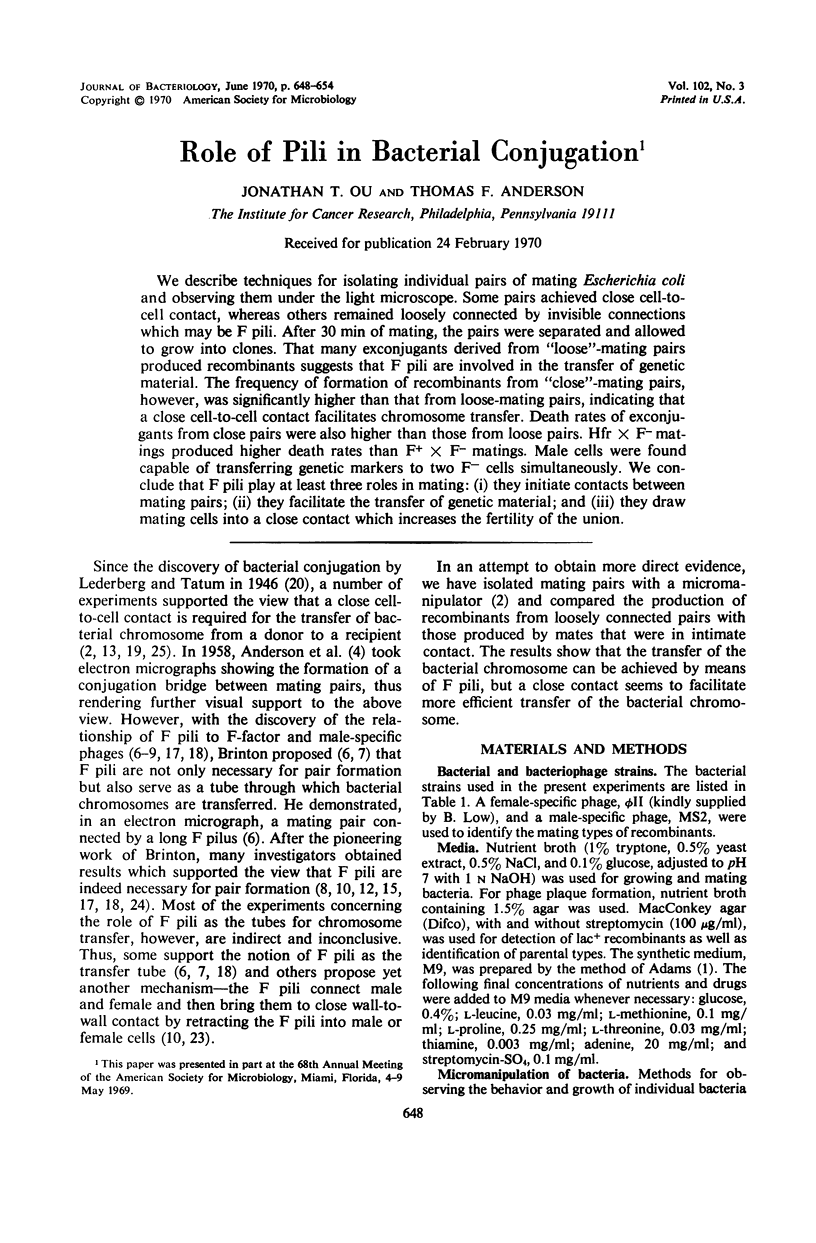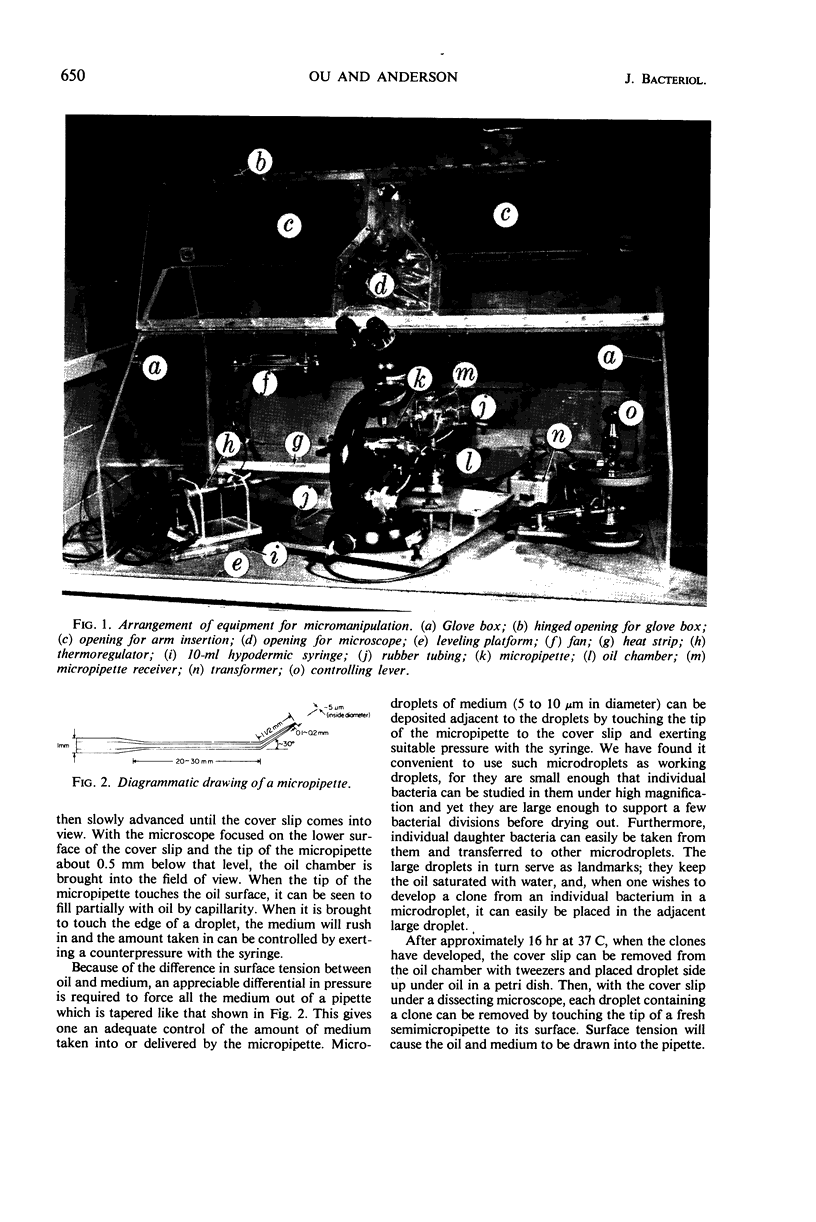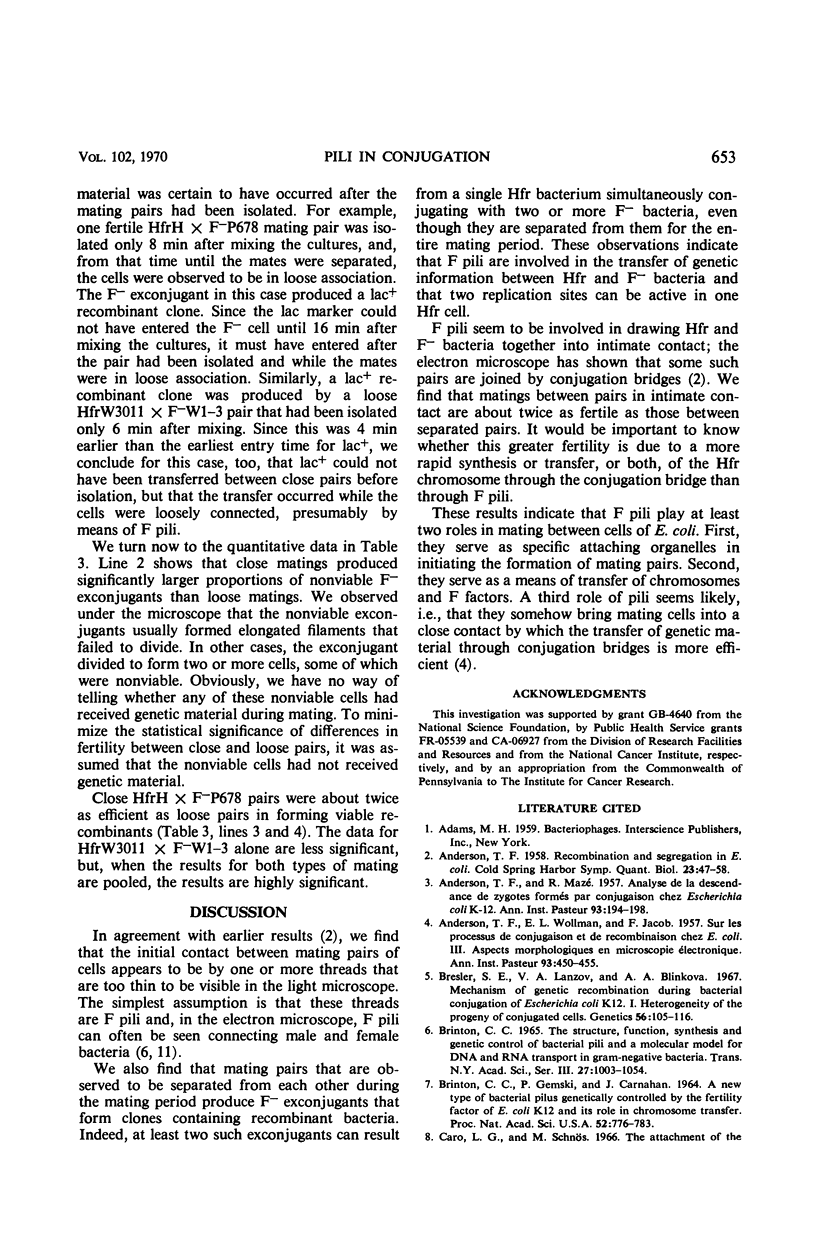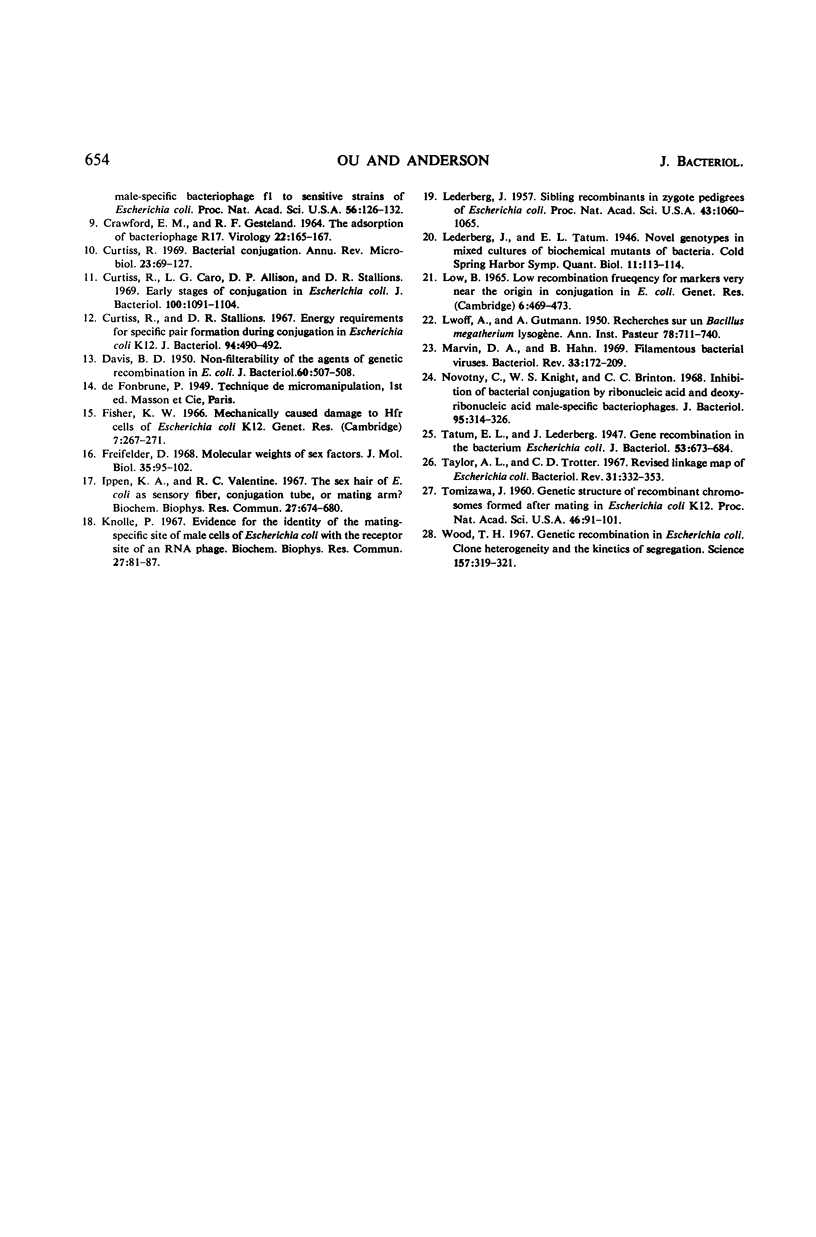Abstract
We describe techniques for isolating individual pairs of mating Escherichia coli and observing them under the light microscope. Some pairs achieved close cell-to-cell contact, whereas others remained loosely connected by invisible connections which may be F pili. After 30 min of mating, the pairs were separated and allowed to grow into clones. That many exconjugants derived from “loose”-mating pairs produced recombinants suggests that F pili are involved in the transfer of genetic material. The frequency of formation of recombinants from “close”-mating pairs, however, was significantly higher than that from loose-mating pairs, indicating that a close cell-to-cell contact facilitates chromosome transfer. Death rates of exconjugants from close pairs were also higher than those from loose pairs. Hfr × F− matings produced higher death rates than F+ × F− matings. Male cells were found capable of transferring genetic markers to two F− cells simultaneously. We conclude that F pili play at least three roles in mating: (i) they initiate contacts between mating pairs; (ii) they facilitate the transfer of genetic material; and (iii) they draw mating cells into a close contact which increases the fertility of the union.
Full text
PDF






Images in this article
Selected References
These references are in PubMed. This may not be the complete list of references from this article.
- ANDERSON T. F., MAZE R. Analyse de la descendance de zygotes formés par conjugaison chez Escherichia coli K12. Ann Inst Pasteur (Paris) 1957 Aug;93(2):194–198. [PubMed] [Google Scholar]
- ANDERSON T. F. Recombination and segregation in Escherichia coli. Cold Spring Harb Symp Quant Biol. 1958;23:47–58. doi: 10.1101/sqb.1958.023.01.007. [DOI] [PubMed] [Google Scholar]
- ANDERSON T. F., WOLLMAN E. L., JACOB F. Sur les processus de conjugaison et de recombinaison chez Escherichia coli. III. Aspects morphologiques en microscopie électronique. Ann Inst Pasteur (Paris) 1957 Oct;93(4):450–455. [PubMed] [Google Scholar]
- BRINTON C. C., Jr, GEMSKI P., Jr, CARNAHAN J. A NEW TYPE OF BACTERIAL PILUS GENETICALLY CONTROLLED BY THE FERTILITY FACTOR OF E. COLI K 12 AND ITS ROLE IN CHROMOSOME TRANSFER. Proc Natl Acad Sci U S A. 1964 Sep;52:776–783. doi: 10.1073/pnas.52.3.776. [DOI] [PMC free article] [PubMed] [Google Scholar]
- Bresler S. E., Lanzov V. A., Blinkova A. A. Mechanism of genetic recombination during bacterial conjugation of Escherichia coli K-12. I. Heterogeneity of the progeny of conjugated cells. Genetics. 1967 May;56(1):105–116. doi: 10.1093/genetics/56.1.105. [DOI] [PMC free article] [PubMed] [Google Scholar]
- Brinton C. C., Jr The structure, function, synthesis and genetic control of bacterial pili and a molecular model for DNA and RNA transport in gram negative bacteria. Trans N Y Acad Sci. 1965 Jun;27(8):1003–1054. doi: 10.1111/j.2164-0947.1965.tb02342.x. [DOI] [PubMed] [Google Scholar]
- Caro L. G., Schnös M. The attachment of the male-specific bacteriophage F1 to sensitive strains of Escherichia coli. Proc Natl Acad Sci U S A. 1966 Jul;56(1):126–132. doi: 10.1073/pnas.56.1.126. [DOI] [PMC free article] [PubMed] [Google Scholar]
- Curtiss R., 3rd Bacterial conjugation. Annu Rev Microbiol. 1969;23:69–136. doi: 10.1146/annurev.mi.23.100169.000441. [DOI] [PubMed] [Google Scholar]
- Curtiss R., 3rd, Caro L. G., Allison D. P., Stallions D. R. Early stages of conjugation in Escherichia coli. J Bacteriol. 1969 Nov;100(2):1091–1104. doi: 10.1128/jb.100.2.1091-1104.1969. [DOI] [PMC free article] [PubMed] [Google Scholar]
- Curtiss R., 3rd, Stallions D. R. Energy requirements for specific pair formation during conjugation in Escherichia coli K-12. J Bacteriol. 1967 Aug;94(2):490–492. doi: 10.1128/jb.94.2.490-492.1967. [DOI] [PMC free article] [PubMed] [Google Scholar]
- DAVIS B. D. Nonfiltrability of the agents of genetic recombination in Escherichia coli. J Bacteriol. 1950 Oct;60(4):507–508. doi: 10.1128/jb.60.4.507-508.1950. [DOI] [PMC free article] [PubMed] [Google Scholar]
- Fisher K. W. Mechanically caused damage to Hfr cells of Escherichia coli K12. Genet Res. 1966 Apr;7(2):267–271. doi: 10.1017/s0016672300009678. [DOI] [PubMed] [Google Scholar]
- Freifelder D. Studies on Escherichia coli sex factors. IV. Molecular weights of the DNA of several F' elements. J Mol Biol. 1968 Jul 14;35(1):95–102. doi: 10.1016/s0022-2836(68)80039-7. [DOI] [PubMed] [Google Scholar]
- Ippen K. A., Valentine R. C. The sex hair of E. coli as sensory fiber, conjugation tube, or mating arm? Biochem Biophys Res Commun. 1967 Jun 23;27(6):674–680. doi: 10.1016/s0006-291x(67)80088-3. [DOI] [PubMed] [Google Scholar]
- Knolle P. Evidence for the identity of the mating-specific site of male cells of Escherichia coli with the receptor site of an RNA phage. Biochem Biophys Res Commun. 1967 Apr 7;27(1):81–87. doi: 10.1016/s0006-291x(67)80043-3. [DOI] [PubMed] [Google Scholar]
- LWOFF A., GUTMANN A. Recherches sur un Bacillus megatherium lysogène. Ann Inst Pasteur (Paris) 1950 Jun;78(6):711–739. [PubMed] [Google Scholar]
- Lederberg J. SIBLING RECOMBINANTS IN ZYGOTE PEDIGREES OF ESCHERICHIA COLI. Proc Natl Acad Sci U S A. 1957 Dec 15;43(12):1060–1065. doi: 10.1073/pnas.43.12.1060. [DOI] [PMC free article] [PubMed] [Google Scholar]
- Low B. Low recombination frequency for markers very near the origin in conjugation in E. coli. Genet Res. 1965 Nov;6(3):469–473. doi: 10.1017/s0016672300004341. [DOI] [PubMed] [Google Scholar]
- Marvin D. A., Hohn B. Filamentous bacterial viruses. Bacteriol Rev. 1969 Jun;33(2):172–209. doi: 10.1128/br.33.2.172-209.1969. [DOI] [PMC free article] [PubMed] [Google Scholar]
- Novotny C., Knight W. S., Brinton C. C., Jr Inhibition of bacterial conjugation by ribonucleic acid and deoxyribonucleic acid male-specific bacteriophages. J Bacteriol. 1968 Feb;95(2):314–326. doi: 10.1128/jb.95.2.314-326.1968. [DOI] [PMC free article] [PubMed] [Google Scholar]
- Tatum E. L., Lederberg J. Gene Recombination in the Bacterium Escherichia coli. J Bacteriol. 1947 Jun;53(6):673–684. doi: 10.1128/jb.53.6.673-684.1947. [DOI] [PMC free article] [PubMed] [Google Scholar]
- Taylor A. L., Trotter C. D. Revised linkage map of Escherichia coli. Bacteriol Rev. 1967 Dec;31(4):332–353. doi: 10.1128/br.31.4.332-353.1967. [DOI] [PMC free article] [PubMed] [Google Scholar]
- Tomizawa J. GENETIC STRUCTURE OF RECOMBINANT CHROMOSOMES FORMED AFTER MATING IN ESCHERICHIA COLI K12. Proc Natl Acad Sci U S A. 1960 Jan;46(1):91–101. doi: 10.1073/pnas.46.1.91. [DOI] [PMC free article] [PubMed] [Google Scholar]
- Wood T. H. Genetic recombination in Escherichia coli: clone heterogeneity and the kinetics of segregation. Science. 1967 Jul 21;157(3786):319–321. doi: 10.1126/science.157.3786.319. [DOI] [PubMed] [Google Scholar]



